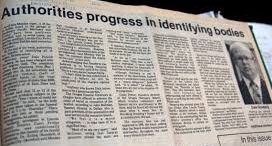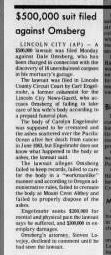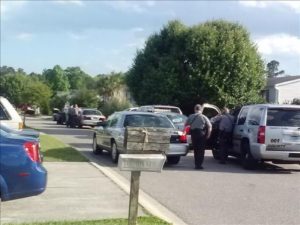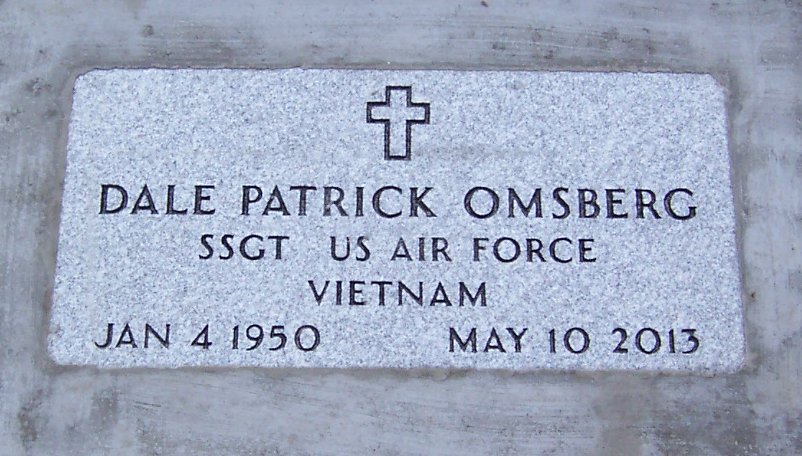
Mortician’s mistreated corpses haunted survivors, changed the law, ended in suicide
Foreword
Thirty-five years ago this month — with Halloween looming — local mortician Dale Patrick Omsberg became the subject of the most exhaustive criminal investigation in Lincoln County history. Before all was said and done, police would find 16 decomposing bodies in the troubled 34-year-old funeral home owner’s parlor basement and numerous other unembalmed and unidentified corpses buried in a nearby graveyard.
Sentenced to just 30 days in jail on a series of misdemeanor charges due to lack of legal recourse at the time, the case would revolutionize Oregon crematoria law. Ordered by the courts to leave the county, the financially strapped Vietnam veteran digressed into a wanted sexual assault suspect who would end his own life in 2013 with a self-inflicted gunshot wound to the head during a police standoff at his South Carolina home.
In the following revised account, Homepage Executive Editor Jim Fossum borrows from his personal recollections, renewed research and his own reporting five years ago for the Lincoln City News Guard to recapture and retell the sordid tale of this most gruesome, ghastly and grisliest of crimes . . .
Gather ’round, my friends, come bend an ear, for the creepiest true story you’ll ever hear . . .
Chapter 1
The Site
Eccentric local businessman Kip Ward remembers vividly the astonished workers pulling crumpled, yellowed newspapers from inside the busted walls of the former Pacific View Memorial Chapel in Lincoln City, where Highway 101 and SW Fleet Street intersect.
Used as insulation during a mid-1930s renovation of a former residence into Lincoln City’s first hospital with just five beds, the dated newsprint unearthed during Ward’s 2011 rehabilitation of the structure constructed alongside the town’s main thoroughfare in 1917 proved these walls could indeed talk . . .
If only they could speak of the despicable things to come.
 At a purchase price of $100,000, Ward’s brainchild was to instill renewed vitality to the former holding shelter for the dead by transforming the vacant funeral home into a special events center for celebrations of life. He would replace the abandoned building on two highway frontage lots in Lincoln City with The Eventuary in January 2012 amid promises to retain its historic past.
At a purchase price of $100,000, Ward’s brainchild was to instill renewed vitality to the former holding shelter for the dead by transforming the vacant funeral home into a special events center for celebrations of life. He would replace the abandoned building on two highway frontage lots in Lincoln City with The Eventuary in January 2012 amid promises to retain its historic past.
Saying, “as people, we’re not perfect, so as communities, we’re not perfect either,” Ward desired to preserve documentation of the facility’s intriguing, if troubling, background. “It has a level of discomfort for me, but I’d have to do some wondering if it didn’t,” he said.
However, the disturbing details behind the building’s storied past proved too distressing for even its owner to publicly share and express. Ward determined that mere mention of the pungent death that permeated the air and garnered national headlines in October 1984 too unspeakable to include in the facility’s website description of the structure’s telltale past.
Chapter 2
The Crime
Mike Holden remembers the regrettable details of that otherwise nondescript fall day in 1984 as vividly as he recalls his own birthdate. The then-Lincoln City Police chief was called to the phone while attending a work conference in Wilsonville and told a harrowing story he could not immediately comprehend.
 An anonymous caller had alerted local authorities that resident Dale Patrick Omsberg, a retired U.S. Air Force staff sergeant, had committed incomprehensible improprieties at the place of worship he owned. A search warrant was sought for Pacific View Memorial Chapel while Holden rushed home to encounter a scene he said no one should have to encounter.
An anonymous caller had alerted local authorities that resident Dale Patrick Omsberg, a retired U.S. Air Force staff sergeant, had committed incomprehensible improprieties at the place of worship he owned. A search warrant was sought for Pacific View Memorial Chapel while Holden rushed home to encounter a scene he said no one should have to encounter.
Found in the basement garage were 16 unembalmed and malodorous bodies stacked like cord wood in plywood boxes rather than the sturdier wood ones normally used in cremation. A couple lied decomposing on body-length stainless steel trays.
Keeping many indigestible facts from the public in order to facilitate the investigation, the case was initially assigned to the Lincoln County Sheriff’s Office because it was believed one of Holden’s officer’s relatives might be among the unidentified. Crushingly, the last body found was believed to be the officer’s mother. The family took her remains to Eastern Oregon, but the body they prayed for at burial was not hers.
With calls to his office becoming so frequent and overwhelming, the case was transferred from the county to Holden’s department to handle as the lead enforcement agency. For the next eight months, it was virtually the only case his officers would tend to.
Eighteen-hour days weren’t uncommon to disinter the bodies and place them in a temporary morgue. Police developed a slide show to review the meticulous investigation they had undertaken to help ease the survivors’ pain and suffering.
Dealing with what bordered on mass hysteria, Holden staged periodical news conferences to address the press in what transformed into a public spectacle involving Portland TV cameras. Helicopters flew overhead shooting empty gravesites. Reporters from countless newspapers forced him to answer the same questions over and over again.
Saying the human body was not respected, Holden rebutted rampant but runaway rumors of the horrific deeds Omsberg allegedly committed — gruesome things such as cutting off limbs and pulling teeth from the remains.
An excavation recovered 32 improperly buried bodies from the cemetery, many of which did not match the undocumented remains being sought. At the time DNA profiling was first being developed, police closed the case in May 1985 with 14 bodies unaccounted for.
Chapter 3
The Sentence

Despite undergoing multiple polygraphs, interviews and interrogations, Holden said Omsberg never fully cooperated with police.
A psychiatric evaluation, which the district attorney said factored into his negotiations with Omsberg attorney Stephen Lovejoy, indicated the defendant would likely commit suicide if sentenced to the penitentiary. Lovejoy said his penniless client’s grisly crimes were prompted by financial stress and a declining mental condition.
Omsberg’s defense argued their client’s negligent management of accepting nominal fees for those in need failed to generate enough income to overcome his debt. Omsberg was known to bill the poorer families of the deceased for his services if they could not pay up front, leading to his financial distress.
In a written statement read by Lovejoy to reporters after his client’s sentencing, Omsberg said, “How does one apologize for such a terrible thing that has happened, except to say that I am truly sorry? I didn’t want it to happen and make no excuses. I hope and pray that you will forgive me.”
Incredibly, Omsberg pleaded guilty and was released on good behavior after serving just 23 days of a 30-day jail sentence on 60 misdemeanor charges of theft, attempted theft and abuse of corpse’s bodies beginning in January 1981. He was ordered to pay $18,400 in restitution to the families whose bodies or cremains were found or listed as missing, placed on five years’ probation and ordered out of Lincoln County.
At the time, the only state regulations on crematories were Department of Environmental Quality standards for air pollution. Behind the relentless pursuit of two women intimately involved with the victims, the Oregon Legislature imposed stricter standards on crematoria regulations in its 1985 session.
Bodies are now required to be tracked through extensive paperwork and a stainless-steel tag. A deputy medical examiner is assigned to remain with investigators after deaths are resolved and no longer a medical examiner’s responsibility.
Following the sentencing, investigators began excavating the graveyard on East Devils Lake Road in search of the remains of other bodies for which no cremation or burial records could be found. Hypnosis, lie detector tests and truth serum were used to get Omsberg to share his knowledge and provide a map to reveal the locations of mass graves housing the decrepit bones. Thirteen locations were excavated and 32 bodies found in three graves, but not where Omsberg said.
Chapter 4
The Victims
The true sufferers of Omsberg’s mildly punished crimes were the friends and families of the people he was paid to bury or cremate.
Some survivors forgave Omsberg for his misdeeds, including one whose husband’s body was found Oct. 19, 1984, under a sheet on a table in the mortuary’s garage. She said she prayed for him to be able to put his life back together.
Others weren’t so forgiving.
 “Not only was a law broken by Mr. Omsberg, but a moral trust involving the last act of love and respect from our family for my father has been blasphemed,” Wanda Cogswell said in a May 4, 1985, article by The Associated Press.
“Not only was a law broken by Mr. Omsberg, but a moral trust involving the last act of love and respect from our family for my father has been blasphemed,” Wanda Cogswell said in a May 4, 1985, article by The Associated Press.
Omsberg buried some bodies without caskets to cut costs. Many victims’ families spent months visiting grave sites that didn’t contain their relative’s remains. One family that spread ashes across the Pacific Ocean was left to wonder who they had honored and suffered for the rest of their lives. Others never got that far. A spouse’s skeletal remains were found stuffed in a body bag and left to rot on the basement floor.
“Some people ask, ‘Why don’t you just let it go,’” one victim’s wife told the Eugene Register-Guard on Oct. 6, 1985. “People say the dead are dead, and we should give it up. But when I ask them if they could walk away from it not knowing what had happened to their husband or their wife or their child, they don’t have an answer.”
The incident touched off a firestorm of debate throughout the county with many, including the pastor of St. Peter the Fisherman Lutheran Church, and Omsberg’s longtime physician urging forgiveness. Others weren’t as pardoning.
Death threats to the Omsberg family were common and the children were vilified and had to be sent to private Christian schools. Letters to the Editor dominated the local op-ed pages for months following the findings, exhumations and sentencing, calling it “emotional rape,” “aggravated assault” and “a violation of basic public trust that must not go unpunished.”
Saying they expected their loved ones’ death, “but not this,” 32 families did not receive or were given the wrong cremains.
Epilogue
SOCASTEE, S.C. (Associated Press) — The suspect involved in Thursday’s standoff has died from a self-inflicted gunshot wound, according to Sgt. Robert Kegler with Horry County police. He’s identified as Dale Patrick Omsberg, said Horry County Deputy Coroner Tamara Willard.
Saying justice could never be served for the families who will never learn what truly happened to their beloved, Holden called his reaction to Omsberg’s death “un-Christian.”
It followed an alleged sexual assault that confirmed suspicions that the man who handed urns to victims’ survivors that contained ashes that weren’t those of their kin struggled with demons no one of sane mind can possibly imagine.
According to the incident report, the victim, an acquaintance of Omsberg’s, told police she was in her mobile home in Myrtle Beach when he came up behind her and stuck a stun gun in her back. When she struggled to get away, he stunned her several times, she said.
The victim told officers she fell to the floor and Omsberg, “stood over her and kept telling her that he was going crazy.” She said he told her to take off her clothes and kiss him.
After a struggle, the victim was able to get to the front door and Omsberg let her go, then fled the scene after saying he was going home to kill himself. A search was launched in Omsberg’s neighborhood.

Omsberg, who spent time in several Western states after leaving Lincoln City, was found at his nearby home. Police said officers heard muffled gunshots coming from his house. A SWAT team and negotiators were called in. After nearly two hours, the suspect was found barely breathing, wheeled out on a stretcher and rushed to the hospital clinging to life.
Omsberg died the next day, Friday, May 10, 2013, at Grand Strand Regional Medical Center in Myrtle Beach. Born on Jan. 4, 1950, he was 63.
“It was all a bad dream,” Holden said in a May 1985 interview with The Associated Press. “It was the most emotionally draining investigation I’ve ever been involved in.”










As I’m planning my beach trip, I thought of Dale, and how weirded out I am, every time I pass his former funeral home. My Dad was his insurance agent at this time. We made a trip to Lincoln City, one Saturday, to stop by for some paperwork to be signed. I remember eating Oreos, in the kitchen, while there were rotting dead bodies in the basement.